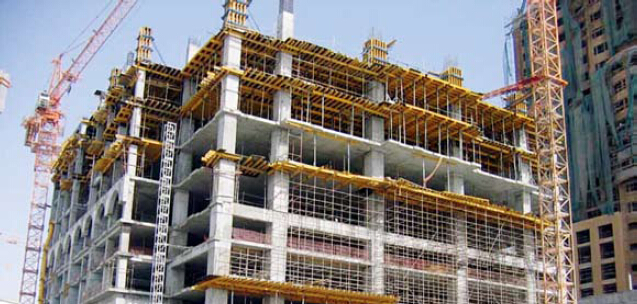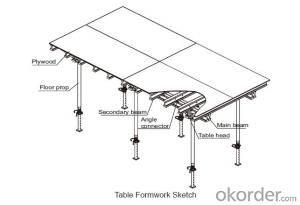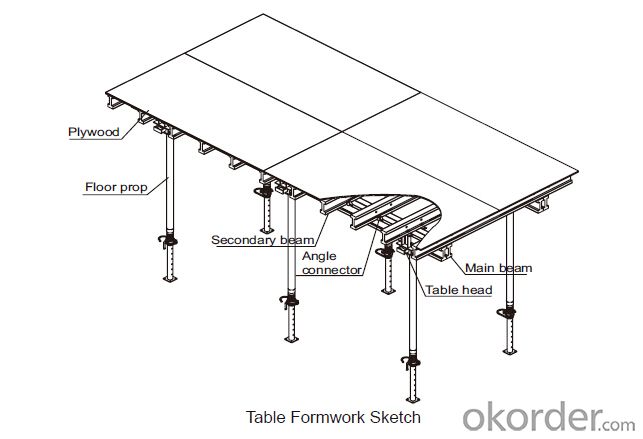Tabel Formwork system for Formwork and Scaffolding Build
- Loading Port:
- Tianjin
- Payment Terms:
- TT OR LC
- Min Order Qty:
- 50 m²
- Supply Capability:
- 1000 m²/month
OKorder Service Pledge
OKorder Financial Service
You Might Also Like
Tabel Formwork:
Table formwork is the most typical application for slab, with timber beam, the slab formwork is
light weight, fast and economic in the construction.
Characteristics:
◆ Simple structure, easy assembly.
◆ Flexible structure, be adapted to different support system.
◆ High construction efficiency with special system tools.
1. Lifting fork for lifting the table formwork to upper floor.
2. Trolley for moving the table formwork on floor.
◆ Flexible application with stand alone props.
◆ Safer condition with handrails.



- Q: Can steel formwork be used for both residential and commercial renovations?
- Yes, steel formwork can be used for both residential and commercial renovations. Steel formwork is a versatile and durable option that can withstand the demands of various construction projects, making it suitable for both residential and commercial renovations. Its strength and stability make it ideal for creating concrete structures in both types of buildings.
- Q: How does steel formwork affect the concrete finish?
- Steel formwork can greatly impact the quality and finish of concrete. It provides a smooth and rigid surface, ensuring accurate alignment and minimizing any distortions or irregularities in the concrete. Additionally, the steel formwork allows for precise control over the placement and compaction of the concrete, resulting in a superior finish with minimal surface defects.
- Q: Can steel formwork be used for underground tunnels?
- Yes, steel formwork can be used for underground tunnels. Steel formwork is a versatile and durable material that is commonly used in construction projects, including underground tunnels. It is able to withstand the pressure and forces exerted by the surrounding soil and rock, making it suitable for use in the construction of tunnels. Additionally, steel formwork is easy to assemble and disassemble, allowing for efficient construction and maintenance of tunnels. Its strength and durability make it a popular choice for underground tunnel construction, providing a reliable and long-lasting solution.
- Q: How does steel formwork affect the overall acoustics of the building?
- Steel formwork can have a significant impact on the overall acoustics of a building. Due to its dense and rigid nature, steel formwork tends to reflect sound waves instead of absorbing them. This reflection can cause an increase in overall noise levels and create echoes within the building. The use of steel formwork can result in a higher reverberation time, which is the time it takes for sound to decay by 60 decibels. This can lead to poor speech intelligibility and reduced clarity of audio within the space. Additionally, the sound reflections from steel formwork can interfere with the natural acoustic properties of the room, potentially causing distortion and resonance issues. To address these challenges, sound-absorbing materials can be added to the interior surfaces of the building. This can help to reduce the reflection and reverberation of sound waves, improving the overall acoustics of the space. Options include the use of acoustic panels, insulation materials, and ceiling treatments that absorb and diffuse sound. It is important to consider the specific requirements of the building and its intended use when deciding on the type of formwork to be used. For spaces where good acoustics are crucial, such as auditoriums, concert halls, or recording studios, alternative formwork materials that provide better sound absorption properties may be preferred over steel formwork. However, in other applications where acoustics are less critical, steel formwork can still be used effectively with the addition of appropriate sound-absorbing measures. Overall, the choice of steel formwork can have a significant impact on the acoustics of a building. Proper consideration of sound absorption and reflection properties, along with the use of additional acoustic treatments, can help to mitigate any negative effects and create a more pleasant and functional acoustic environment.
- Q: What are the common challenges faced during steel formwork reassembly?
- During the reassembly of steel formwork, there are various obstacles that may arise. One primary difficulty is guaranteeing the proper alignment and placement of the formwork components. This entails correctly positioning the steel panels, braces, and connecting rods to ensure they are level and secure. Another challenge involves managing the weight and size of the steel formwork components. The steel panels and beams can be cumbersome and bulky, making it arduous to maneuver and assemble them correctly. This necessitates meticulous planning and coordination to ensure the safe handling and positioning of these elements. Additionally, the complexity of the formwork design can present challenges during reassembly. Steel formwork systems can be intricate, incorporating various interlocking components and connections. It is imperative to comprehend the design and assembly instructions to properly reassemble the formwork and ensure its stability and strength. Proper sequencing and timing also pose significant challenges during steel formwork reassembly. The order in which the formwork components are assembled can affect the overall efficiency and effectiveness of the construction process. It is essential to carefully plan the reassembly and coordinate with other construction activities to avoid delays and ensure seamless progress. Lastly, safety remains a major challenge during steel formwork reassembly. Working with heavy steel components can expose workers to risks, including the potential for falls, lifting accidents, or structural failures. Therefore, it is crucial to establish appropriate safety measures, such as utilizing suitable lifting equipment, providing personal protective equipment, and ensuring workers are trained in safe assembly procedures. Overall, the reassembly of steel formwork demands meticulous planning, coordination, and attention to detail to overcome challenges pertaining to alignment, weight, complexity, sequencing, and safety. By effectively addressing these challenges, construction projects can proceed smoothly and efficiently.
- Q: What type of steel is used in steel formwork?
- Typically, a high-strength, low-alloy (HSLA) steel is employed in steel formwork due to its excellent strength, durability, and resistance to corrosion. HSLA steel is frequently utilized in construction projects that demand a robust and enduring material capable of enduring the challenges of formwork. Moreover, the steel employed in formwork is frequently subjected to special coatings or finishes to further augment its ability to resist rust and other types of deterioration.
- Q: What are the different types of accessories available for steel formwork?
- There are several types of accessories available for steel formwork, each designed to enhance the efficiency and effectiveness of the formwork system. Some common types of accessories include: 1. Formwork clamps: These are used to securely connect the steel formwork panels together. They provide stability and prevent any movement during the concrete pouring process. 2. Formwork wedges: These are used to level and align the formwork panels. They are inserted between the panels and tightened to ensure a tight fit and proper alignment. 3. Formwork ties: These are used to secure the formwork panels to the structure being formed. They are typically made of steel and are inserted through holes in the formwork panels and anchored to the structure. 4. Formwork connectors: These are used to join the formwork panels at corners or junctions. They help in maintaining the structural integrity of the formwork system. 5. Formwork spacers: These are used to maintain a specific distance between the formwork panels. They ensure that the desired thickness of the concrete is achieved. 6. Formwork brackets: These are used to support the formwork panels during construction. They provide additional stability and prevent any sagging or bending of the panels. 7. Formwork release agents: These are used to prevent the concrete from adhering to the formwork panels. They are applied to the panels before pouring the concrete, allowing for easy removal of the formwork once the concrete has set. 8. Formwork handles: These are used to facilitate the handling and positioning of the steel formwork panels. They provide a secure grip and help in ensuring proper placement of the panels. 9. Formwork chamfers: These are used to create beveled edges on the concrete. They are attached to the formwork panels to give a finished look to the concrete structure. 10. Formwork accessories for special applications: There are also specialized accessories available for specific formwork requirements, such as formwork for curved structures, formwork for columns, or formwork for beams. These are just a few examples of the various accessories available for steel formwork. The type of accessories needed will depend on the specific project requirements and the desired outcome. It is important to select the appropriate accessories to ensure a successful and efficient formwork system.
- Q: What are the different types of ties used with steel formwork?
- There are several types of ties commonly used with steel formwork, including snap ties, taper ties, she-bolts, wedge bolts, and pins. These ties help secure the formwork panels together and ensure the stability and strength of the structure being formed.
- Q: What are the different safety certifications and standards for steel formwork?
- There are several safety certifications and standards that apply to steel formwork. These certifications and standards ensure that the steel formwork meets specific safety requirements and can be used safely in construction projects. Some of the different safety certifications and standards for steel formwork include: 1. ISO 9001: This certification ensures that the steel formwork manufacturer has implemented a quality management system and meets the necessary quality standards. It focuses on the overall quality and reliability of the product. 2. ISO 3834: This certification ensures that the welding processes used in the production of steel formwork are carried out in accordance with specific quality requirements. It emphasizes the welding quality and ensures that the welds are strong and durable. 3. EN 12812: This European standard provides guidelines for the design and performance of formwork systems, including steel formwork. It covers aspects such as load-bearing capacity, stability, and safety requirements for formwork systems. 4. OSHA: The Occupational Safety and Health Administration sets safety standards for the construction industry in the United States. While there are no specific certifications for steel formwork, compliance with OSHA standards is essential to ensure a safe working environment for construction workers using steel formwork. 5. BS 5975: This British standard provides recommendations for temporary works, including formwork systems. It covers aspects such as design, erection, use, and dismantling of formwork systems, ensuring safety throughout the construction process. 6. ACI 347: This American Concrete Institute standard provides guidelines for the design, construction, and maintenance of concrete structures. It includes recommendations for formwork systems, including steel formwork, to ensure their safety and effectiveness in supporting the concrete during construction. These certifications and standards play a crucial role in ensuring that steel formwork is manufactured and used safely in construction projects. By adhering to these certifications and standards, construction companies can ensure the safety of their workers and the quality of their structures. It is important for construction professionals to be aware of these certifications and standards and ensure compliance with them when using steel formwork.
- Q: How does steel formwork contribute to the fire resistance of the structure?
- Steel formwork, also referred to as steel molds or frames, plays a crucial role in enhancing the fire resistance of a structure. Primarily, steel possesses inherent fire-resistant properties due to its high melting point and low combustibility, making it an optimal choice for formwork in areas prone to fires. When steel formwork is employed in construction, it imparts strength and rigidity to the structure, thereby preserving its integrity during a fire. These steel molds securely hold the concrete in place, preventing its collapse or disintegration when exposed to elevated temperatures. This structural stability enables firefighters to enter the building safely and extinguish the fire without concerns of sudden structural failure. Furthermore, steel formwork acts as a heat sink during a fire by virtue of its high thermal conductivity. This characteristic facilitates the rapid absorption and dissipation of heat, thereby minimizing the spread of fire and reducing the overall temperature within the structure. By absorbing heat, steel formwork effectively delays the occurrence of concrete spalling or cracking, thereby maintaining the structural integrity of the building for an extended duration. In addition, steel formwork is often designed with appropriate fire-resistant coatings or insulation materials. These coatings provide an additional layer of protection against heat, flames, and smoke generated during a fire. They also aid in impeding or slowing down the transfer of heat to the concrete, thereby further augmenting the fire resistance of the structure. Overall, the utilization of steel formwork significantly enhances the fire resistance of a building by providing structural stability, functioning as a heat sink, and incorporating fire-resistant coatings or insulation materials. By incorporating steel molds, architects and engineers can ensure the safety and longevity of the structure, even in the event of a fire.
Send your message to us
Tabel Formwork system for Formwork and Scaffolding Build
- Loading Port:
- Tianjin
- Payment Terms:
- TT OR LC
- Min Order Qty:
- 50 m²
- Supply Capability:
- 1000 m²/month
OKorder Service Pledge
OKorder Financial Service
Similar products
Hot products
Hot Searches


















